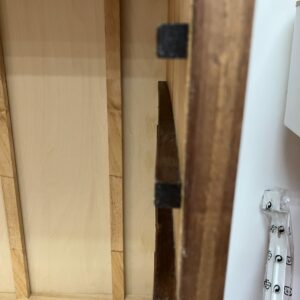Nice to meet you all!
I am an amateur in woodworking and just built the first cabinet for my tiny workshop. The sides of cabinet are made of 5/8″ (16 mm) pine. The back is a sheet of thin plywood. There are 9 drawers made of plywood. The slides are some stripes made of walnut, glued and nailed on the sides.
It has been raining for a week in where I live, so the sides of the cabinet are now bowed. I could still open and close the drawers but they are a little bit too tight now.
Here are my questions:
– Is gluing the wood slides to the side actually a bad idea? The sides and slides contract/expand in different directions, would the glued slides (instead of nailed only) cause the bowing or at least make the bowing worse?
– Any suggestion on fixing it? I was thinking about adding a cross brace (a piece of wood from one side to another side), screwed or nailed from outside to “pull” the bowed sides inwards. I guess it may work (a little bit) but it does not sound like a good solution to me.
Any advices would be appreciated. Thank you very much!
Kat















Replies
I think the sides are cupped? Cupping is across the width of a board. Bowed is along the length.
By gluing the runners to the sides, you have prevented the sides from expanding and contracting with changes in humidity. That causes a lot of problems. I'd use a screw in the front, and a screw in a slot toward the rear, to allow expansion. And make the slides a little shorter than the sides.
In a taller cabinet I like a solid divider about halfway up. It adds strength and rigidity, can keep the sides flat, and can be used instead of one pair of drawer runners.
Hi John, thanks a lot for your explanation. English is not my first language and I did not notice the difference between bowed and cupped before...the sides may have been warped in both ways - they are cupped; the drawers at the middle are stuck more than those at the top and at the bottom, so I think the sides are also bowed a little bit.
Anyway I will try to remove those glued slides and re-attach the slides with screw and with a slot as you advised. Hopefully i can remove those slides without damaging the sides too much.
I did heard of wood movement but I have very limited experience in working with solid wood...I have definitely underestimated how much wood can actually move.
First, your English is perfect.
Second, don't feel bad about the difference between bowing and cupping; outside the woodworking community, very few people would know.
CM
Just one side or both? By definition, plywood does not expand and contract like lumber, that's why its so useful in applications like cabinets and substrate for veneer. That said, unequal moisture on either is a common cause of warping.
Most of the movement with ply is associated with unsupported positioning, like leaning it against a workbench, etc. or a previously bowing piece that gets worse after assembly for some strange reason, but I've had it happen. More often than not, it's because I didn't notice until installing slides.
As you've said, easy enough to figure out - remove the slide strips. A heat gun combined with gentle persuasion from a 16oz hammer oughta do it. If they bowing goes away after a couple days, you have your answer. But I'm pretty sure the answer is "the bow is there to stay."
But hold your horses!! Why not just install a divider go bring it back to straight?
Dear robertejr,
The sides of my cabinets are made of solid pine wood (a low-quality one, though) but not plywood. Both left and right sides are cupped - So my guess is that my glued slides have caused or worsened the cupping of the sides.
Thanks for your suggestion on divider! I have a similar idea but I also have few questions:
My wood slides are 1 cm wide stripes, around 5 cm apart from each other. My drawers are around 4.5 cm tall and they slide between two slides with very little space left. So my plan is to remove at least one pair of slides, add a 1 cm thick board as a divider which also allows my drawer to slide on.
Is it better to use solid wood (the same pine board) for the divider, or, plywood as it does not move so it can "lock" the sides?
Can I use glue to attach the divider? Or, fasteners like nails/screws/brackets are always the best solution as they allow movements?
I hope my questions make sense. Thanks!
This forum post is now archived. Commenting has been disabled